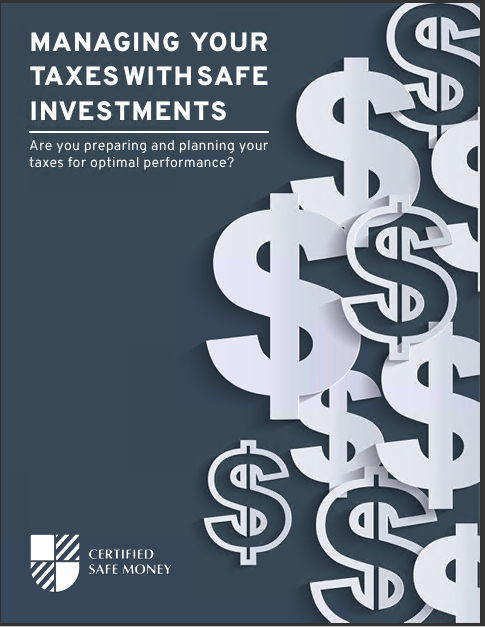Safe Money Investments Safe Investments for Keeping Your Money Secure
The stock market has been anything but predictable – especially over the past dozen years or so. Take, for instance, early in the year 2020. In February, the Dow Jones Industrial Average (DJIA) reached an all-time high of 29,569.58, only to drop by more than 30% over the next few weeks.While nobody likes to lose value in their portfolio, if you’re getting close to your intended retirement date, even a slight stock market “correction” can make a significant impact on your future lifestyle. Because of that, it is important to keep at least some portion of your assets in safe investments.
The Best Safe Investments for Keeping Your Money Secure
Many of today’s investment vehicles have a lot of “moving parts.” As an example, options, futures, and other financial derivatives can be somewhat confusing to track. Plus, even though these investments can offer the opportunity for a big payoff, more often than not, they can also subject investors to a significant risk of loss.Safe financial vehicles, on the other hand, are typically straightforward and easier for investors to understand. These financial tools can also offer protection of principal – even in the most volatile of market environments, like the Great Recession of 2008.Some of the most common safe investments and financial vehicles include:
- Savings Accounts – A savings account is an interest-bearing deposit account that is held at a bank, credit union, or another type of financial institution. Savings accounts generally pay a modest interest rate and allow access to your funds at any time. This makes savings accounts a good option for parking “emergency funds” or other funds that you are setting aside for a specific goal, such as a down payment on a new home.
In some cases, the financial institution where you have a savings account may require that you keep a minimum balance to avoid monthly charges and fees. You can oftentimes “link” a savings account and a checking account so that you can easily transfer funds from one to the other.
Pros and Cons of Savings Accounts
Savings Account AdvantagesDrawbacks of Savings AccountsEasy to openLow interestFDIC insured (up to the maximum limit)Interest is taxableLiquid / easily accessibleMay require maintaining a minimum balanceSafe / keeps principal protected
- Money Market Accounts – A money market account is an interest-bearing account that can also be opened at a bank or a credit union. Money markets will usually pay a slightly higher rate of interest than a regular savings account (with the “tradeoff” being that the money market account may not be quite as flexible). Many money market accounts allow you to write checks against the funds that are stored there. This can offer an added degree of convenience.
Pros and Cons of Money Market Accounts
Money Market Account AdvantagesDrawbacks of Money Market AccountsPrincipal protectionLower interest rate than some other types of fixed investments/financial vehiclesHigher interest than a regular savings accountInterest is taxableFDIC insured (up to the maximum limit)May be required to keep a minimum balanceFlexible (i.e., may have check writing and/or debit card privileges)May only be allowed a limited amount of transactions per month
- Certificates of Deposit (CDs) – Certificates of deposit, or CDs, are often referred to as time-bound deposits. With these financial vehicles, you exchange a lump sum of cash in exchange for a set rate of interest (which is usually higher than that of a savings account). Upon maturity, you collect your principal, as well as the interest that was earned.
Typically, longer maturities on CDs will equate to a higher rate of interest. If you liquidate a CD before its maturity date, you will usually incur a penalty or fee. CDs are considered to be safe investments, and they won’t lose value if there is a downward movement in the stock market.
Pros and Cons of Certificates of Deposit
CD AdvantagesCD DrawbacksSafetyLimited liquidityHigher interest than a regular savings accountLow returnsFixed, predictable returnsTaxable interest
- Bonds – Bonds are defined as fixed income financial instruments that represent a loan made by an investor to a borrower – which is typically a corporation or a government entity. There are many different types of bonds to choose from, such as:
- Corporate Bonds – Corporate bonds are a type of debt security that is issued by a company and sold to investors. In return for receiving the capital that it needs, the company (i.e., the borrower) will pay the investor a set rate of interest for a specified period of time. When the time period has elapsed (i.e., when the bond reaches maturity), the investor will receive their initial principal back.
- U.S. Government Savings Bonds (Series I and Series EE) – The United States government offers savings bonds that are low risk and reliable interest-bearing vehicles. The Series EE bond, which is oftentimes referred to as a “Patriot Bond,” is guaranteed to at least double over the typical 20-year initial term. (Some Series EE bonds may have a maturity of up to 30 years). These bonds require a minimum $25 investment, and investors may purchase up to $10,000 in Series EE bonds every calendar year. The government also offers Series I bonds. These bonds earn a combined fixed and variable rate, helping investors maintain purchasing power over time. U.S. government savings bonds may not be purchased in the open market but are bought only through TreasuryDirect.
- Municipal Bonds (Munis) – Municipal bonds, or “munis,” are debt securities issued by a state, municipality, or county to finance various expenditures, such as the construction of schools, roads, or bridges. These bonds are exempt from federal taxes, as well as most state and local taxes. Therefore, muni bonds can be particularly attractive to investors who are in a high-income tax bracket.
- U.S. Treasury Inflation-Protected Securities (TIPS) – United States Treasury Inflation-Protected Securities, or TIPS, are Treasury bonds that are indexed to an inflationary gauge in order to help with protecting investors from a decline in their purchasing power. With these investments, the value of the security will go up as inflation rises. The interest payment will vary with the adjusted principal value of the bond.
Pros and Cons of Investing in Bonds
Advantages of BondsDisadvantages of BondsProtection of principalLow rate of returnStable, consistent returnLess liquid than savings accounts or money market accountsUsually, a higher interest rate than savings accountsExposure to interest rate risk
- Money Market Mutual Funds – Money market mutual funds invest in highly liquid, near-term financial instruments, such as cash and other cash-equivalent securities, as well as in U.S. Treasuries. These financial vehicles offer a low level of risk combined with a high degree of liquidity. (It is important to note that money market mutual funds are not the same as money market accounts).
Pros and Cons of Money Market Mutual Funds
Money Market Mutual Fund AdvantagesMoney Market Mutual Fund DisadvantagesSafety / Principal protectionLow rate of returnLiquiditySome potential for loss
- Bond Mutual Funds – A bond mutual fund (or simply a bond fund) is a type of mutual fund that invests solely in bonds. For many investors, a bond fund is a more efficient way to invest in bonds than purchasing individual bond securities. In addition, unlike purchasing individual bonds, a bond mutual fund does not have a maturity date for the repayment of principal to the investor. Therefore, the amount of investors’ principal may fluctuate from time to time with these funds. Also, investors do not directly participate in interest payments with a bond fund like they do when they own individual bonds.
In many cases, bond funds are made up of a certain type of bonds, such as government or corporate. They can be even further defined by the time period to maturity, like short-term, intermediate-term, or long-term. In other instances, a bond mutual fund may invest in risky, high-yield (or “junk”) bonds. In return for the high amount of volatility, these types of bonds can also offer the opportunity for a higher return.
Pros and Cons of Investing in Bond Funds
Bond Mutual Fund ProsBond Mutual Fund ConsEasier than purchasing individual bondsLower return potential than stocksLower risk than stocksNot completely risk-free (especially if the fund includes junk bonds)More diversified than purchasing an individual bondSubject to interest rate riskMore liquid than owning individual bondsThe value of the bond fund can decrease when interest rates go upHigher return than CDs and money market accounts
- Fixed Annuities – Another safe haven for investors’ money is a fixed annuity. These financial vehicles represent a contract between an individual and an insurance company whereby, in return for either a lump sum or multiple contributions, the annuity will offer a set rate of return, as well as the opportunity to receive an ongoing income stream for a specific period of time (such as ten or twenty years), or even for the remainder of the income recipient’s life, regardless of how long that may be. This certainty of income can help to alleviate one of the biggest concerns on the minds of many retirees today – that of running out of money while they still need it.
Some fixed annuities are immediate. This means that they start to pay out income right away (or within 12 months of the investor making a contribution). Other fixed annuities are deferred. This means that they can pay out income at a time in the future. During the “accumulation” period (i.e., the period of time before the annuity is converted over into an income stream) in a fixed annuity, the growth that takes place in the account is tax-deferred, meaning that there is no tax due on the gain until the time of withdrawal.Fixed annuities offer principal protection in any type of stock market environment. For this reason, fixed annuities are often purchased by those who are retired or who are approaching that time in their lives. In return for this safety, though, a fixed annuity oftentimes pays a low rate of return.As with most annuities, fixed annuities will usually include a surrender period. During this time, if the annuity is canceled – or even if the investor withdraws more than a certain percentage of the account value in a given year – they will incur a withdrawal charge. In addition, if the individual is under age 59 , they can also be required to pay an additional 10% IRS “early withdrawal” penalty.Many fixed annuities offer additional features, though, which can make them even more enticing for some investors. These features may include a(n):
- Death Benefit – If the annuitant (i.e., the income recipient) has not received back all of his or her annuity contributions before they pass away, a death benefit may be paid out to a named beneficiary.
- Terminal / Chronic Illness Waiver – Should the annuitant be diagnosed with certain terminal and/or chronic illnesses, it may be possible to withdraw more than a minimum amount from the annuity without incurring a surrender penalty.
- Long-term Care Waiver – If the annuitant requires care in a nursing home facility, he or she may be allowed penalty-free access to the funds in the account.
Fixed Annuities – Pros and Cons
Fixed Annuity AdvantagesFixed Annuity DrawbacksPrincipal protectionLow returnSet rate of returnSurrender periodTax-deferred growthPossible 10% IRS early withdrawal chargeOngoing income (possibly for life)Added features such as a death benefit and/or waiver for terminal illness, chronic illness, and long-term care needs
- Fixed Indexed Annuities – Fixed indexed annuities are a type of fixed annuity. The key difference between the two types of annuities is the way in which the return is determined. For instance, with a fixed indexed annuity, the return is based on the performance of an underlying market index, such as the SP 500. If the index performs well during a given calendar year, then the annuity is credited with a positive return – usually up to a set maximum, or “cap.”
However, if the underlying index performs poorly and incurs a loss, the annuity will not lose value. Rather, it is typically credited with a guaranteed minimum or “floor.” This is usually in the range of 0% to 2%. When the underlying index performs well again, there are no losses to make up for. Therefore, future returns can continue to be built upon past gains in the account.Given their ability to produce a higher return than that of a regular fixed annuity – along with its principal protection – fixed indexed annuities have become popular with those who are nearing retirement.Like other types of annuities, the gain that takes place inside a fixed indexed annuity is tax-deferred, so the funds can grow and compound exponentially over time. In addition, fixed indexed annuities can also offer an income stream for a certain period of time or even for life.Like with regular fixed annuities, fixed indexed annuities may also provide additional features, such as a death benefit, a chronic or terminal illness waiver, or a waiver for long-term care expenses.
Pros and Cons of Fixed Indexed Annuities
Fixed Indexed Annuity AdvantagesFixed Indexed Annuity DrawbacksPrincipal protectionLimited, or “capped,” returnOpportunity for a higher return than a regular fixed annuitySurrender periodTax-deferred growthPossible 10% IRS early withdrawal chargeOngoing income (possibly for life)Added features such as a death benefit and/or waiver for terminal illness, chronic illness, and long-term care needs
What Percentage of Your Portfolio Should Be Low Risk?
Because everyone’s objectives, time frame, and risk tolerance are different, there is no single percentage of low-risk investments in a portfolio that is right for everyone across the board. For instance, for investors who are risk-averse and want to keep their principal safe, allocating more lower-risk assets is likely the best strategy.Alternatively, if the goal of the portfolio is to attain aggressive growth, then fewer assets should be placed in low-risk financial vehicles. (This may be the case for younger investors who have a longer time horizon until retirement, and thus, more time to make up for losses that may be incurred.)
Is Your Portfolio as Safe as It Should Be?
To determine the right asset allocation for your specific needs, it is recommended that you discuss your goals with an experienced retirement financial advisor who can provide you with more information and assist you with narrowing down the best financial tools for you.













